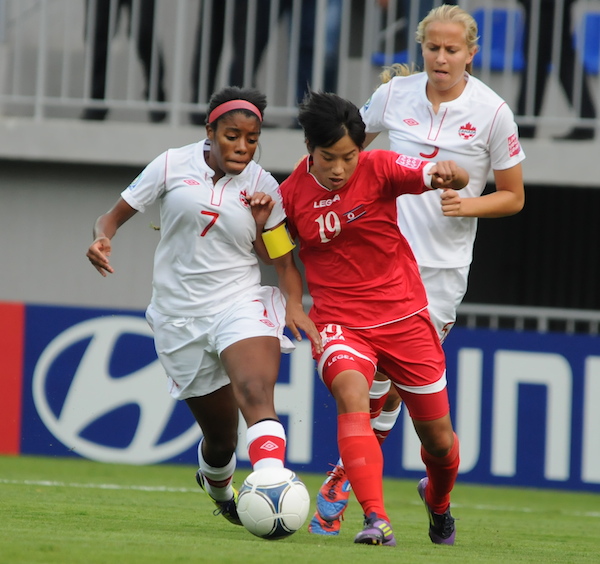One of the common criticisms of women’s soccer, once you get by all of the more virulently idiotic bigoted nonsense, is that women’s soccer tournaments, like the World Cup, aren’t as exciting as men’s tournaments because there isn’t enough parity. This criticism contends that the strong teams are too strong and too few and the rest of the teams are too weak. As a result, the World Cup or Olympics are long periods of boring cake-walks of the great teams over the poor with only a few games of evenly matched soccer in the semifinals and finals. It’s unclear whether people who subscribe to this line of thought believe that an ideal tournament would be made up of completely even teams or if they believe in some ideal distribution of skill.
No matter, what I was curious about and what I wanted to see was how the frequently criticized women’s World Cup would compare to the men’s edition of the tournament. To do that, I took data from the Group Stage of this year’s women’s World Cup and the 1982 men’s World Cup held in Spain. Why 1982? Aside from it being my birth year, like this year’s women’s tournament, 1982 was the first time the men’s field expanded from 16 teams to 24. Like in Canada this year, the expansion in 1982 opened the World Cup to a number of countries who had never made the field before.
New countries:
- 1982 men’s World Cup – Algeria, Cameroon, Honduras, Kuwait and New Zealand
- 2015 women’s World Cup – Cameroon, Costa Rica, Ecuador, Ivory Coast, Netherlands, Spain, Switzerland, Thailand
This difference can be attributed to the much longer history of men’s World Cups before expanding to 24. The men’s World Cup began in 1930 and was held 11 times while it grew from 13 to 24. The women’s World Cup was first held in 1991 with a field of 12 and took only six tournaments to expand to 24 teams.
In order to determine parity, I took the scores of the Group stage games and analyzed them. If women’s soccer is truly evolving in a less competitive (and therefore exciting) way, we’d expect there to be more blow-outs and fewer closely fought matches. We’d expect to see more games like Germany’s 10-0 beat-down of Thailand in 2015 than we would Hungary’s 10-1 beat-down of El Salvador in 1982. The first way I broke out the games was by goal differential — 0 if the two teams tied, 1 if the winning team scored one goal more than the losing team, regardless if that was a 1-0 win, a 2-1 win, or a 11-10 win (there are none of those in soccer.)
1982 men’s World Cup goal differential
- 0 – 12 games – 33%
- 1 – 11 games – 31%
- 2 – 4 games – 11%
- 3 – 6 games – 17%
- >3 – 3 games – 8%
2015 women’s World Cup goal differential
- 0 – 10 games – 28%
- 1 – 15 games – 42%
- 2 – 3 games – 8%
- 3 – 0 games – 0%
- >3 – 8 games – 22%
How you read these numbers depends entirely on how you perceive two goal and three goal games. If you think a 2-0 game or a 3-0 game is a blow-out and not exciting, then you’d conclude that the women’s game is more exciting in 2015 than the men’s game was in 1982. A full 70% of all the group games in 2015 were decided by less than two goals, while only 64% were that close in 1982. If, however, you think that anything less than a four goal difference is representative of a pretty even matchup, you’d conclude that there are almost three times more blow-outs in the women’s 2015 World Cup than in the men’s 1982 World Cup. As with almost anything, you can interpret the data how you want. I would argue that a three goal differential is enormous in soccer and unlikely to occur between teams of close to even strength. As such, my conclusion is that, while there are a few more severely lopsided games in 2015 women’s competition than there were in men’s competition in 1982, there are also more very close games in 2015 than in 1982.
Another way to look at the same data is to focus not on goal differential but on the most common soccer scores: 0-0, 1-0, 1-1, 2-1, and 2-0. When I looked at the data that way, I discovered that exactly the same percent of the games in both tournaments fell within that range – 66%. There was some variety within those scores but not enough to seem meaningful in any way.
Overall, the 2015 Group Stage games were a little bit more high scoring (107 goals compared to 100) and although there were a few more closely competitive games, there were also a few more wild blow-outs which led to a higher average goal differential (1.75 in 2015 compared to 1.5 in 1982.) Frankly, it’s quite surprising how similar the numbers are across gender and generations. The women’s game in 2015 is not as evenly matched as the men’s game in 2015 is but it’s basically exactly where the men’s game was in 1982 when its World Cup expanded to 24 teams and the women’s game has arrived at this point much faster.
All the data I got for this post was taken from the Wikipedia entries for the 1982 men’s World Cup and 2015 women’s World Cup. You can view or copy the data here. Please give attribution if you use it.


Very interesting research. I like the way you show two different interpretations of the same data.